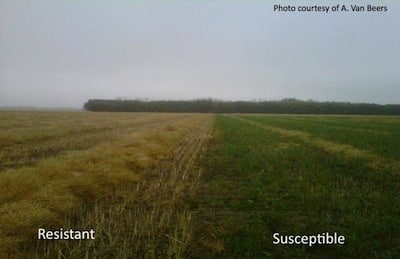
Growing clubroot resistant varieties in areas with low levels of inoculum or areas beside regions known to have clubroot is a good pre-emptive strategy to keep clubroot to a minimum in a particular field.
The question for growers in areas with serious blackleg is whether to grow varieties with effective blackleg resistance or grow varieties with clubroot resistance. Current varieties do not always offer both. Some considerations when making the decision:
1. Blackleg is a known and immediate threat to canola yield in some parts of the Prairies. For example, incidence of blackleg has tripled in Manitoba in the past six years. In this case, choosing a variety with known effective blackleg resistance can provide an immediate return in terms of higher yield.
2. Overall, if blackleg is not a significant risk and if clubroot resistant seed is available, then clubroot resistance should be used to prevent the disease from increasing. Clubroot may be present on a farm in an undiagnosed capacity, and if susceptible varieties are grown there, it will increase to epidemic levels in two cycles. To use the Manitoba situation as an example again, clubroot is found in Manitoba, and Cavalier county just over the border in North Dakota has a few rather severe cases that seemed to come on suddenly. Growing clubroot resistant varieties in areas closest to Cavalier county will help to keep clubroot low in these fields. If not growing a clubroot resistant variety in these regions, growers need to take all other measures to manage clubroot: monitor soil for spore load, scout for galls, use minimum till, and control brassica weeds and canola volunteers.
3. Blackleg can be effectively managed on a four year rotation, even if genetic resistance is not strong. Clubroot will essentially never be eliminated once established.
4. Testing soil for clubroot can be an effective way to monitor for the disease before it starts to cause noticeable plant damage. By the time plant damage is showing up, inoculum levels are probably already quite high in a field. Pull samples from highest risk areas of the field — which are field entrances. Find the point where iron first hits the field, and concentrate on this small area. Take soil from the top 1” from five locations in the area and send it to a lab. Manitoba has a brand new Pest Surveillance Lab that will test soil for clubroot DNA. It opens to the public in January. Winter tests can be effective. Clubroot spores are extremely hardy, and test checks for DNA — so spores don’t have to be alive anyway.
5. Clubroot can go from 100s or 1,000s of spores per gram of soil to millions of spores per gram of soil within one or two cycles growing susceptible varieties.
